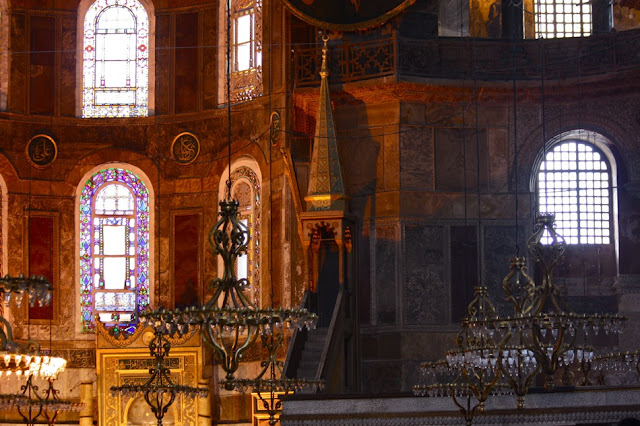 |
| Hagia Sophia |
We just returned from Istanbul where everything we have heard and read about is true: Istanbul is beautiful. After we got done with the "mandatory" tourist attractions in the Old City referred to as the Sultanahmet area, we spent most of our time in the other neighborhoods, especially Beyoğlu (bey-yoh-loo) where we stayed, and discovered more and more about the city until we realized that there is so much deeper one can dig into the many layers of this city. It rained most of the days we were there and though it wasn't pouring rain, it was just one of those wet days where it was irritating enough when walking on the streets that you might want to use an umbrella. The Sultanahmet area is where the historical attractions congregate (Hagia Sophia, Sultanahmet Mosque, Basilica Cistern, Topkapi Palace, etc) and they are so close in proximity to one another that on a wet day, it was easy to just let ourselves wander into each of them and immerse ourselves in it. Damp weather or not, it did not take the essence of the city away from us. This is the first of the many posts to come and in true spirit of our physical visit, the first few posts will be on these historical attractions followed by our further discovery of the city itself.
The Hagia Sophia (aya-sophia) is really quite a marvel. Now a UNESCO World Heritage Site, it was originally built as a church during the Byzantine Empire. The Ottoman Empire who later conquered Turkey converted Hagia Sophia into a mosque. When Turkey officially became a secular country, this structure was then turned into a museum. To date, Hagia Sophia is considered as having one of the greatest Byzantile-style architecture.
 |
| 12 lambs representing the 12 apostles |
One of the elements of Hagia Sophia that I find the most beautiful is the juxtaposition of Christianity and Islam within its great walls. Given its history of having been first a church and then a mosque, artwork bearing Christian images were kept even after the building was converted into an Islamic house of worship. Today we see Christian and Islam elements and motifs existing side-by-side and together they create awe. This isn't something we see often today, if at all.
 |
| Artwork depicting Virgin Mary with the child Jesus and a plaque with Arabic words. |
To get up to the mezzanine level, walk through the dim passageways that will bring you up after multiple turns. Yes it brings you closer to the ceilings with faded artwork that carry much history but it's also where fine mosaic artwork are on display.
Photography tips: tripods are not allowed into the Hagia Sophia. All visitors must have their bags go through a scan and if they find a tripod in your bag, you will need to check that in and collect it on your way out. Prior to our visit, I've read reviews where some visitors have brought in their gorillapod or monopod without the scanning machine detecting it. We brought our gorillapod along and figured that if we had to check it in, it wasn't a big deal. The scan machines are smarter these days it seems and of course it detected our gorillapod. At the end of our visit, we realized that we could make do without it and still get pretty good shots. There are many columns inside the Hagia Sophia that you can use as a stability support for your arm when you take the pictures. Crank up the ISO as well and you will be more than fine. Go early to avoid the busloads of tourists.
--
Istanbul's Old City Pt II: Sultanahmet Mosque
Istanbul's Old City Pt III: Yerebatan Cistern, Divan Yolu



















No comments:
Post a Comment